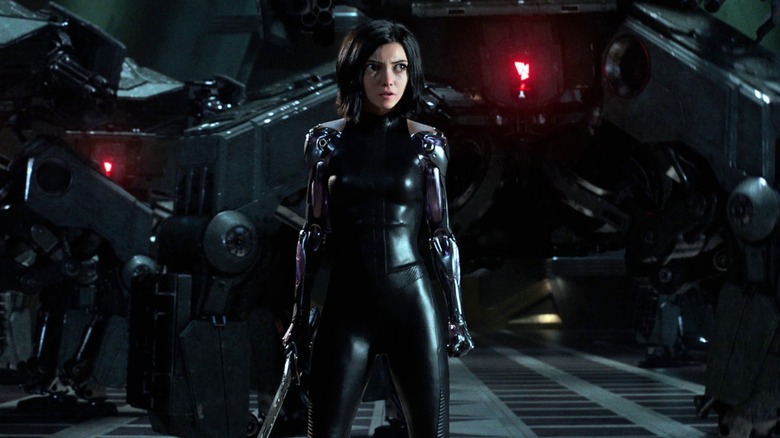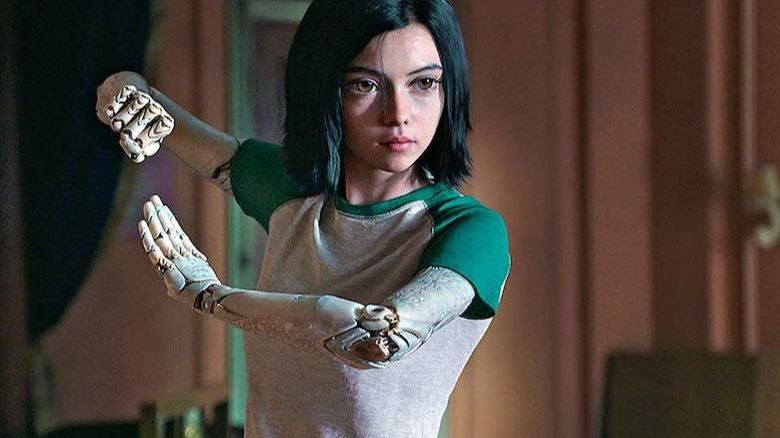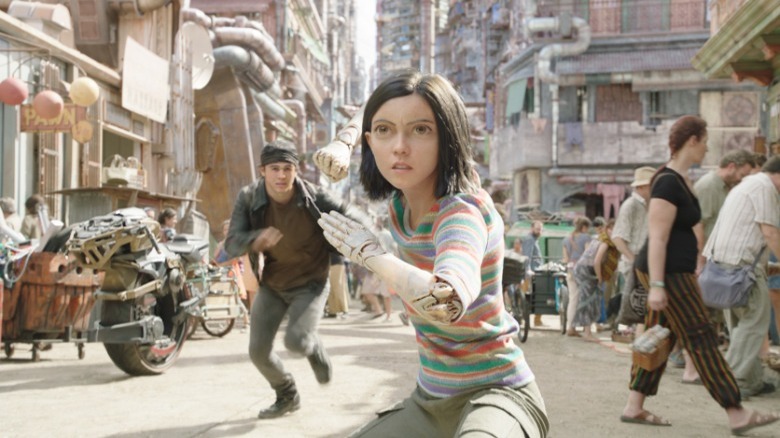Creating Alita: Battle Angel's CGI Hero Was Almost Like A Real-Life Birth
When James Cameron set out to adapt Yukito Kishiro's acclaimed cyberpunk manga "Gunnm," also known as "Battle Angel Alita," he made the decision to shelve the project for 20-something years until technology caught up to his requirements for the film's world-building. This is a quintessentially James Cameron thing to do, given that he is the kind of director who knows how to be patient enough until he has the best tools to translate his ambitious artistic visions into reality. By the time Cameron had access to the right kind of technology for the long-gestating "Alita: Battle Angel," he found himself preoccupied with "Avatar," a project that demanded meticulous dedication (and ended up altering the trajectory of performance capture technology in filmmaking forever). As a result, Cameron handed over the reins to long-time friend Robert Rodriguez, while still being involved with the adaptation as a producer and supervising its creative direction.
Rodriguez, who shouldered the immense responsibility of bringing Cameron's vision to life, was understandably worried about the challenges that came with depicting the lead, Alita, an amnesiac cyborg girl who drives the dystopian story forward. Moreover, Rosa Salazar, who assumes the titular role, had to walk the fine line between depicting someone who is not quite human and appealing to audiences by functioning as the emotional core of the narrative. A mix of live-action and computer-generated imagery allowed the manga-esque aspects of Alita to blossom on-screen, without making her CGI appearance clash with the organic aspects of her surroundings. Although Rodriguez and co. were in the good hands of New Zealand's Weta studios, which spearheaded the creation of a computer-generated version of Alita based on Salazar's performance, the process of creating a live-action Battle Angel was laboriously long and almost akin to a real-life birth.
'A lot like the human birthing process'
In a 2019 interview with Rolling Stone, Robert Rodriguez and "Alita: Battle Angel" producer Jon Landau broke down the process of translating the minute aspects of Rosa Salazar's performance into Weta's computer-generated version of Alita. The process started with the digital scanning of Salazar's face and the creation of a live-action version of Alita that captured the actor's mannerisms while fine-tuning her appearance to suit the character's anime-inspired aesthetics. Landau clarified that the digital version was created only after Salazar came on board, as her "little idiosyncrasies" were pivotal to who Alita is:
"We wanted all of the little idiosyncrasies that she brought in her audition to be there. We learned from doing 'Avatar' that when you're scanning someone's facial structure that it was important to get the lower part of someone's face right — it's harder than you think. Once we knew we could do that, we started working with them on the whole digital process of creating what Alita would look like."
While Alita looks like an augmented CGI version of Salazar on the surface, the process of achieving the character's final appearance took nine months, prompting Rodriguez and Landau to equate it to "the human birthing process." Landau also explained that Weta's primary challenge was to push the envelope of facial and performance capture, which was achieved with the aid of high-definition cameras and made the experience more "actor-centric." The heavy use of digital tech and VFX in films often runs the risk of overshadowing its practical aspects and human performances, but in this case, digital-Alita only enhanced Salazar's dynamic performance instead of overwriting it. This was made possible with incredible attention-to-detail and the measured use of Salazar's moving rendition of the cyborg battle-angel as the blueprint for enhancements.
Tackling world-building
Although Robert Rodriguez had access to digital FX that could aid in the film's world-building, he choose to take a practical, grounded approach by constructing real sets whenever possible. The film's memorable Motorball sequence was actually shot in a high school stadium, with "extras, real sets, and props" to grant a kernel of realism to the near-future Alita inhabits. Most of the characters she interacts with during this sequence are human, and it made sense for Rodriguez to ground the scene by shooting it on a real set as opposed to using a standard green screen. The responsibility of transforming a moderately action-heavy sequence into a high-stakes competitive sports tournament fell to Weta, and they clearly did a great job in the end. Few films are able to sell the premise of a completely unknown sport so convincingly, especially on a visual level that is both thrilling and emotionally-driven.
Every scene that was practically shot had an adjacent digital version, and the combination of the two helped create the core appeal of "Alita: Battle Angel." Although there are valid criticisms that can be directed towards the often-fragmented storytelling, which falters at several points, Rodriguez's film emerges as a trailblazer in terms of world-building. Moreover, no amount of visual spectacle can truly mean anything without compelling characters to ground the story — the film's greatest strength is its ability to generate empathy with the depiction of the bonds between the characters.
At the heart lies Rosa Salazar's Alita, a character whose practical and digital aspects cannot be scrutinized separately, but must be evaluated as a whole. Digital augmentation that mimicked the birthing process aside, Salazar is Alita, and without her, the world-building would crumble within seconds. In spite of its many flaws, "Alita: Battle Angel" succeeds in selling the fantasy.


